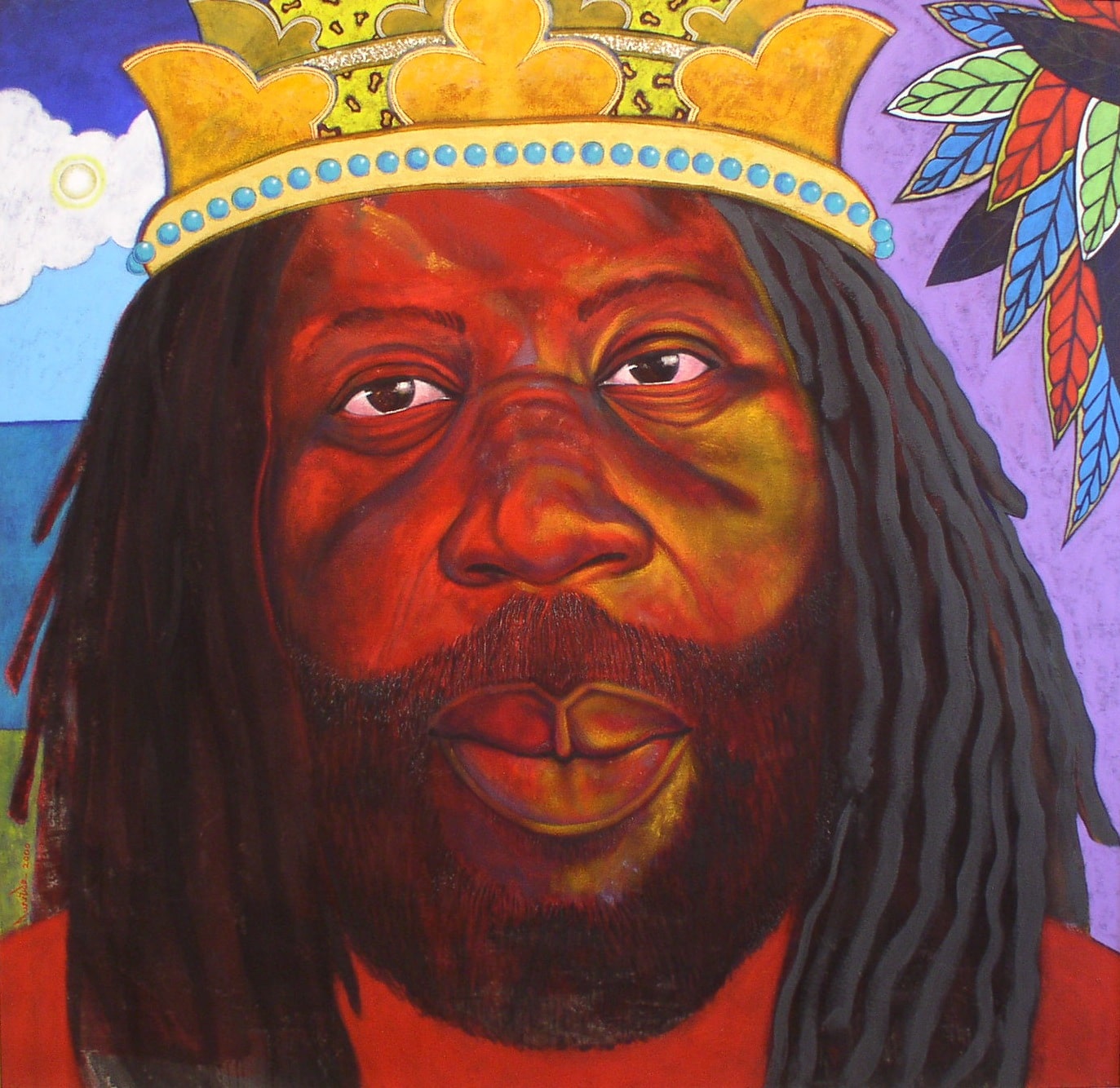
By Natalie Willis
King Solomon, the biblical king of Israel, is revered in Christianity, Judaism, Islam and Rastafarianism alike. A wealthy and wise man (the latter of which people the world over feel are missing in leadership), he was known for his sense of justice and morality, and perhaps most famously known for settling a dispute between two women who fought over the guardianship of a child. We’ve most often seen this son of David, the successor to the throne, depicted as a wizened old man with a beard, looking every inch the grandfather. Why then, do we seem to get such contrasting reactions to Stan Burnside’s “Solomon” (2000) in our space? People claim to love the large scale work or despise it. We’ve had to move it from external spaces on loan because it was seen as “too much” or disconcerting – which feels rather unsettling for our dear Gallery + Collections Assistant, Matthew Rahming, whose likeness is often compared to that of Burnside’s king.
But first, a bit about Burnside. Taken from the incredibly useful online artist resource archive at the D’Aguilar Art Foundation, we have a brief synopsis of just some of this master artist’s contributions to Bahamian art:
“Stanley Burnside (born 1947, Nassau, The Bahamas) is an established painter and sculptor and has been an important artist and leader in the Bahamian art community throughout his career. Burnside’s work tackles political and cultural patterns and often draws inspiration from the role of the matriarch in The Bahamas. His artwork is distinguishable by what he describes as his “use of elemental and mystical symbolism rooted in his African heritage.” Burnside has established himself not only as a masterful painter but as the premiere Bahamian cartoonist. He sketched out his social commentary in Sideburns, an editorial cartoon that ran daily in The Nassau Guardian for decades, except for a brief period when it ran in The Tribune. Having created over 10,000 cartoon panels since 1979, Mr. Burnside has displayed both his intelligence and wit while keeping Bahamian politicians on their toes and memorializing our pop culture and society in general. After receiving his BFA and MFA from Temple University of Pennsylvania, Burnside spent time working in the United States painting and designing album covers for notable R&B artists. After returning to The Bahamas, he distinguished himself as an Art Professor at The College of The Bahamas and as a principle designer for the Saxon Superstars and later the One Family Junkanoo Groups. He was also a founder and co-creator of the artist collective “Jammin”.”
As such, a staple figure himself in Bahamian art, it makes sense that Burnside might take to commemorating another great contributor to Bahamian culture. Looking more closely, we see the face Burnside gives Solomon is familiar to us. It is the face as one of our musical legends: Tony McKay. Positing the face of a Black man as King Solomon, Burnside’s portrait then becomes an exercise in the wider commentary of the art history of the legendary king’s paintings.
The way that King Solomon has historically been imaged is generally a lighter-skinned, occasionally Middle Eastern or almost Mediterranean stereotypical figure. We do not often see him depicted as a Black man. The story of King Solomon is usually an admirable one, most of us in The Bahamas having been taught the tales in school or church, but this large scale image has unnerved people on so many occasions. Still this painting is worth noting. The painting is undoubtedly beautiful, and regal. He has an impressive crown on his impressively-sized head, his face is open, feels kind and almost fatherly. Additionally, his skin is painted in red undertones with golden highlights – the man glows.
Burnside has given us a Bahamian conception of King Solomon. That king, within the cultural lineage of The Bahamas, would be Exuma, the Obeah Man.
The likeness is uncanny, from the eyes to the lovingly rendered locs. He is adorned with regal purple in the background, the shallow seas that he was born in (though some might say he came down on a lightning bolt), and a colourful array of croton (a plant occasionally used in bush medicine, which originates in our Obeah heritage from West Africa). Exuma, Tony McKay, named Macfarlane Gregory Anthony Mackey at his birth, was born in Cat Island, known for its bush medicine and deference to spirit (and indeed spirits). Burnside’s coronation speaks to Exuma’s simultaneous influence on, and preservation of Bahamian culture, and brings in a bit of magic to the biblical sovereign as he has been conceived in some circles as a magician or an exorcist – so why not an Obeah man too?
This work is currently on view as part of “TimeLines: 1950-2007”, the new rehang of the National Collection curated by Richardo Barrett.